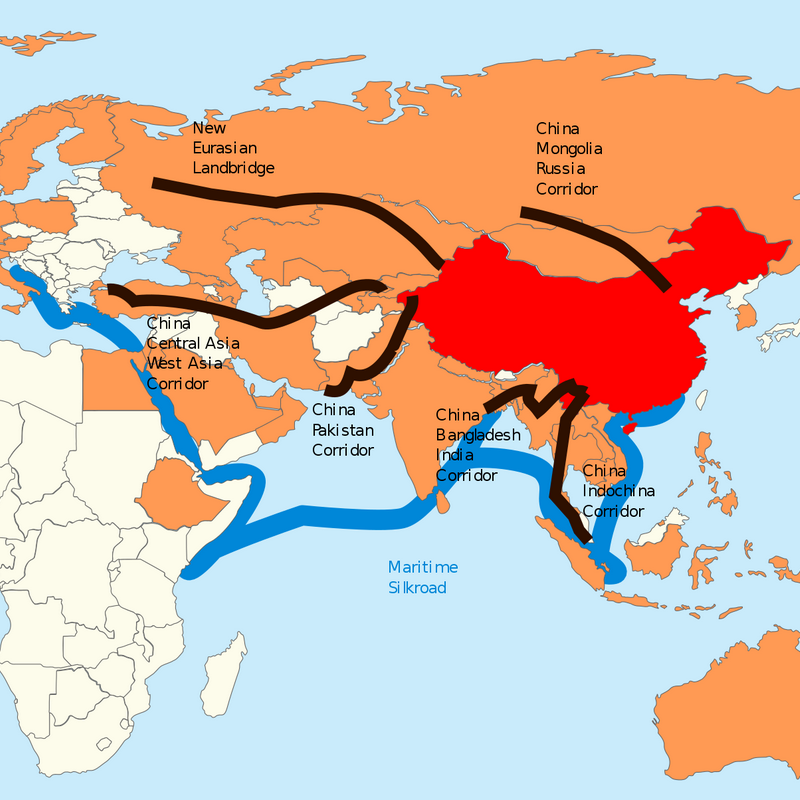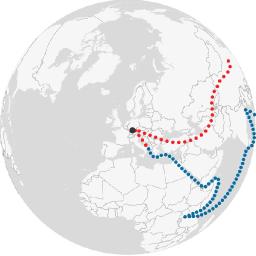Germany's 'China City': how Duisburg became Xi Jinping's gateway to Europe


The city is host to the world’s largest inland port , with 80% of trains from China now making it their first European stop.

In 1585, it was in Duisburg that Flemish cartographer Gerardus Mercator published a book of maps of European countries – the first ever “atlas” to carry that name. And it was here that Mercator first presented his new world map, the “Mercator projection”, that was so revolutionary for maritime navigators keen to steer merchant vessels across the high seas in the straightest possible line.
If in 2018 Duisburg is slowly rediscovering its cosmopolitan past, it is not just because four centuries after Mercator, traders are still trying to find the most direct route from A to B. As the threat of Donald Trump’s tariffs and Brexit-related trade barriers is driving wedges between the EU and the Anglosphere, this former rust-belt town town allows one to see in real time how Germany and China are intensifying their economic ties.
Every week, around 30 Chinese trains arrive at a vast terminal in Duisburg’s inland port , their containers either stuffed with clothes, toys and hi-tech electronics from Chongqing, Wuhan or Yiwu, or carrying German cars, Scottish whisky, French wine and textiles from Milan heading the other way.
In Duisburg’s port, where train tracks run straight to the edge of the Rhine River, goods are loaded straight on to ships, stored for further dispatch in one of several football pitch-sized storage units, or sent on by train or truck to Greece, Spain or Britain.
Duisburg was already regarded as the world’s largest inland port. But thanks to the Belt and Road infrastructure project – a revival of the Silk Road route that Mercator had read about in the travelogues of Marco Polo, this time subsidised with billions of dollars by the Chinese government – the port is fast becoming Europe’s central logistics hub. Around 80% of trains from China now make it their first European stop, with most using the northern silk road route via Khorgos on the China-Kazakhstan border and the Russian capital, Moscow.

How Duisburg connects to China’s
Belt (red) and Road (blue) routes.
“We are Germany’s China city,” says Sören Link, Duisburg’s Social Democrat mayor. For years, his city has been a symbol of the challenges of long-term structural changes facing industry in the Ruhr region: in 1987, photographs of thousands of Krupp steelworkers barricading a bridge over the Rhine protesting against imminent factory closures travelled around the world.
In 2018, Duisburg’s unemployment rate of 12% is still almost four times as high as the German average, but at least the viral images are different: four years ago the Chinese president, Xi Jinping, made Duisburg one of the few stops on his state visit to Germany and was welcomed by an orchestra playing traditional mining songs. “There are signs that the city’s importance will keep growing,” says Link. “We could become China’s gateway to Europe – and vice versa.”

Krupp steelworkers occupying a bridge over the Rhine in 1987.
Ullstein Bild/Getty Images
And while the west’s appetite for gadgets made in China shows no sign of abating, one of the main European products heading east is powdered milk – a result of low trust in domestic brands following a 2008 food safety scandal . If that trust returns, even fewer containers may be heading east from Duisburg.
“The ratio used to be 4:1, so it has improved, but we still have an imbalance,” admits Erich Staake, the port’s CEO. A former TV channel manager, he is not shy to take credit for the entrepreneurial spirit of the port. Since taking charge in 1998, employment at Duisport has soared from 19,000 to 50,000.
While other German port cities such as Hamburg run their harbour “like a landlord”, Staake says, Duisburg has worked to court new trade, modernising its logistics infrastructure and even setting up its own railway company. He is building a new 20,000 sq metre storage unit where China Railways will be able to neatly stack 2,000 containers.

Chinese President Xi Jinping Visits Duisburg in 2014
and welcomes the arrival of the Yuxinou container train,
linking Duisburg directly with Chongqing.
Pool/Getty Images
“Rail freight between Chongqing and Duisburg is almost twice as expensive as shipping, but takes 12 days instead of 45. Air freight is at least twice as expensive as rail freight, but takes on average five days. If we can reduce lead times even further, below 10 days on average, then that opens up a lot more potential.”
But in Germany, some have been quick to sound a note of caution. If the still-recovering industries in western Germany make themselves too reliant on China, they warn, it could provide economic leverage for an authoritarian regime that wants to project its geopolitical power into western Europe. “What’s good for Duisburg isn’t necessarily good for the world,” cautioned one recent article .
For now though, China’s soft power barely registers in the region. The number of Chinese citizens living in the city has doubled in the past eight years – but from a low base of 568. The local Duisburg-Essen University houses a Confucius Institute and attracts the largest number of Chinese students in Germany, most of whom study engineering and economic sciences. They support a growing network of relatively authentic Asian fast food joints which now compete with the kebab houses introduced by a previous generation of migrants.

Hans Blossey/© duisport
The number of Chinese businesses in the city has risen, too – up 50% since Xi visited in 2014 – but, again, there are still only 90. Unlike other cities on the New Silk Road, the port remains German-run.
The reasons journey times from China are still far too long, as Staake sees it, lie mainly with the heavily unionised rail companies in Europe rather than their counterparts in Asia: trains take on average six days to travel the 1,300km (800 miles) from Brest on the Polish-Belarusian border to Duisburg, while the 10,000km from Chongqing to Belarus is often completed in five-and-a-half days.
“The Chinese and the Kazakhs drive thousands of kilometres a day, they really work hard. It’s ridiculous, really. Of course we are trying to work out why this is happening. You know how many train drivers’ unions we have, and the Poles are not much better,” says Staake.
At the Duisburg city museum, visitors can still listen to the chants and jeers of the workers who went on strike over the closure of the steelworks in the 1980s and early 90s. A button hidden inside a wall made of original Ruhr valley coal triggers a recording. The modern Duisburg port with all its modern marvel, however, has yet to find its place in the city’s memory.
In the entrance hall to the museum, a wall greets visitors with the words for “welcome” in the languages of all the migrant workers who have shaped the city, from Kurdish to Greek to Polish. For now, the Mandarin or Cantonese phrases for “welcome” do not feature.


... and the beat goes on... ...
... ... and the beat goes on...